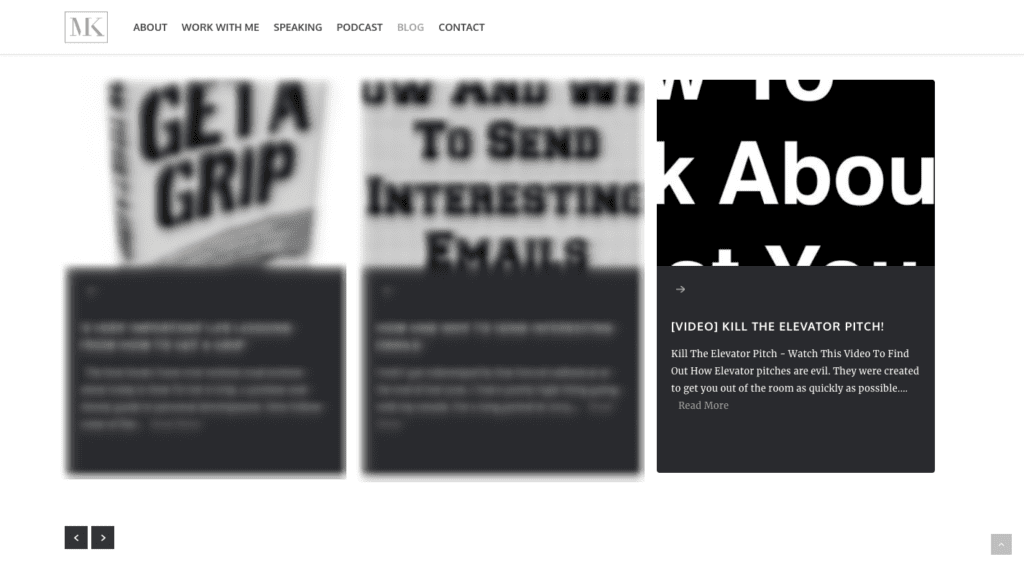There are many reasons to write blog posts for your audience. They demonstrate authority, allow you to build trust and give you another way to add value. But you won’t be able to benefit from this content marketing if no one ever clicks on the posts you’ve written.
The blog post title sets the stage for a blog post. It makes a promise to people who encounter it:
“This is what this blog post will do for you if you open it.”
Take, for instance, this blog post Brian Tracy shared on Twitter:
While the message itself might’ve gotten a few glances, it’s that striking blog post title that probably made people read it, like it and share it with others.
“Will Brian Tracy show me what it takes to become a successful entrepreneur, too???”
Today, we’re going to look at how to write blog post titles that people won’t be able to stop themselves from opening.
How to write better blog post titles
You want people to see your posts — on your blog, in search results, and when shared on social media — and to feel like they need to find the answers to their questions and problems there.
So, how do you write a title that does that?
Here are some things you can do to start writing better blog post titles:
1. Don’t overthink it.
Just start with something simple. For instance, does your post answer one of the 5 W’s or How questions?
That’s how Gabby Bernstein approached this title:
This post is a step-by-step guide that shows people how to use creative visualisation. So, why over-complicate the title? The promise of learning how to do this is compelling enough.
That said, just because simple is better doesn’t mean you can’t put an original spin on it (so long as it remains clear). For instance, this is the blog of Brene Brown:
Notice how she’s utilised the 5 W’s. However, the titles are anything but ordinary. One of them leverages the name of a famous writer and offers to share tips handed down from her.
Another one of them asks, “Which Book Should I Read First?” This could’ve been written the way most blogs would handle it (i.e. “5 Books You Need to Read Next”), but Brene used a unique approach and turned a commonly asked question into a blog post title.
2. Speak like your audience.
It’s easy to get hung up on keywords when you hear so much about the importance of SEO and getting your blog posts to rank in Google. But sometimes it makes more sense to ditch the overly technical or unnatural sounding blog post titles for ones that sound more human. More specifically, ones that sound the way your clients talk.
This is a recent post from Marie Forleo’s blog:
She could’ve given it a title like, “What to Do When Criticism Stands in the Way of Your Professional Goals”. It might sound professional, but a title like this is written more for search engines than avid followers. The decision to use a conversational tone works much better in this case, especially because her post is so informally written.
So, unless you’re writing a technical guide for your readers or trying to publish something on Forbes.com, feel free to spice your titles up with jargon. It’s a good way to get people’s attention.
3. Keep it short.
A tool I like to use to keep my blog post titles in check is CoSchedule Headline Analyzer. Not only does it tell you how click-worthy your titles are, but it provides guidance on how to refine them. For instance:
The ideal length for a blog post title is 55 characters, which usually comes out to about 6 words. I know it seems short, but think about what happens when your content shows up on mobile or someone shares it on social media.
This is a recent post from Melissa Ambrosini:
It’s positively worded and makes it clear what the reader is going to get out of it. On the blog, it looks great. When it shows up elsewhere, however, the title gets cut off:
A similar thing happens when it’s shared on Twitter:
This isn’t necessarily an argument against writing longer blog post titles (sometimes, anyway). Just be mindful of how you write longer titles. I suspect that Melissa’s post still gets clicked often since it’s front-loaded with value (“how to hack your sleep”), so people get still get the gist of what it’s about.
4. Stay away from clickbait.
If you use a clickbait or spammy title to over-sell an idea or mislead people, you’re likely to see it backfire on you. Sure, you’ll see a lot of clicks, but you’re not looking for people to see your posts. You want them to read it and take action afterwards (i.e. read more content, subscribe to your blog, follow a link, call you, etc.).
I know it’s tempting to use shock and awe to compel people to click on your blog posts. But keep in mind what we talked about earlier. It’s always a good idea to err on the side of simplicity. It’s also important to accurately convey what people will get out of reading your content.
Tony Robbins does a good job of using powerful words in his blog post titles that still accurately describe what readers are about to get:
“Get Ahead”
“Becoming Unshakeable”
“Red Flags”
This just goes to show you that you can evoke a huge emotional response from people without having to trick them into anything.
As for finding those powerful and emotional words? Well, part of that depends on whom you’re writing for. That said, there are a bunch of lists online that can help get you started, like this one from Sumo which has over 400!
5. Include elements that make people want to click.
Research has shown that there are certain elements that can increase the clickability of a blog post.
Numbers, for instance, do especially well because they quantify what’s inside a blog post. Simon Sinek’s blog has a bunch of these:
In these examples, it’s 100% clear what the reader will walk away with.
Numbers also give readers an idea of how much time they’re going to have to invest in a blog post before ever even opening it. For instance, you know right away that a post about the 5 things you should do won’t take too much time to get through, which is likely to make it more attractive to those who are time poor.
Another clickable element you can use is brackets []. Here’s an example of how they’re used by Matthew Kimberley:
Brackets signal that there’s more to a post than just words and images on a page.
[Video]
[Infographic]
[Free Download]
When you want to clue readers into something more that they’re going to get out of a post, use brackets to do that.
There are other elements you could add to your blog post titles (like emoji), but I’d recommend starting with the basics for now. If you can master those, you can start experimenting with other creative title formulas.
Wrap-up
Could your own blog post title be the motivation people need to read your content? It could be!
Think of blog post titles like windows to your content. If you write them in a way that’s vague or misleading, it’s going to be difficult to convince people to read them. Provide them with a clear view of the valuable information that lies ahead, though, and you’ll see more and more people flock to your content (and your business!)

Cat Townsend
Founder of the Good Alliance
After more than a decade spent helping big brands sell more stuff, to people that didn’t need it; Cat set a simple intention: To do more work that made a positive difference in the world. So The Good Alliance was born…


























0 Comments